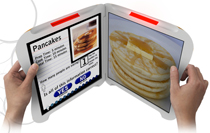Designing For Life
Ron Kuhr, a retired entomology professor, has a 41-year-old son with autism. He’s not alone. The prevalence of autism in children has grown from one in a thousand to nearly one in a hundred over the past few decades.
Like many families dealing with autism, the Kuhrs – Ron and his wife Mary – share a concern that doesn’t seem to have a quick fix. How, they wonder, will their son Matt learn to cope with the challenges of daily living.
They worry that complete independence for their son may be out of reach.
“Matt will always require some sort of assistance,” said Mary Kuhr. “He will never live alone. That is not to say that he can’t become more independent.”
Focus on Independence
That’s the goal of Community Contact, a hands-on course at NC State that gives industrial design students real-world experience designing products for people with disabilities.

In past years the undergraduate class has focused on helping people with arthritis, impaired vision and mobility problems. Autism presented some new challenges for the students, said Associate Professor Percy Hooper.
“We had to do a lot of research. There were plenty of opportunities for making mistakes,” he said.
People with autism may have difficulty communicating and keeping a schedule and may be hypersensitive to noise and light. Some have trouble coping with change.
To help them learn about autism, the students visited the Creative Living Center in Raleigh, a program run by the Autism Society of North Carolina. The center helps more than 20 autistic adults acquire life skills.
Putting Ideas to the Test
Last week the center hosted an event at which several NC State students presented their inventions:
> A day-planning device that uses pictures and color coding to prompt the user through daily chores.
> A pillow that lets the sleeper know if it’s time to rise.
> A headset that shields certain frequencies of light and dampens sound.
About 30 instructors, parents and participants viewed the presentations, which included sketches and 3D models. They challenged the students on some aspects of their designs and applauded them on others.
The Kuhrs liked several of the products, including a durable video player designed by student Andrew Kyriakoulis that plays customized, how-to videos about daily grooming.
“There was something there for everyone,” said Mary Kuhr. “It wasn’t just one size fits all.”
Her husband agreed. “It’s hard to imagine our son living alone,” he said. “But he has become more independent and some of these devices could add to that.”
Go Behind the Scenes with the Students
- Categories:


